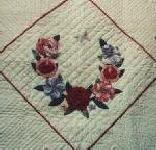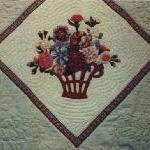America's Quilting History
The Elegance of Sampler Album Quilts

We've all signed autograph albums and their modern counterpart the school year book. But in the first half of the 1800s autograph albums reached a height of popularity unknown today. By 1820 many a parlor table was graced by an album where guests would sign their names along with inspirational phrases. By the 1830s magazines, including the popular "Godey's Lady's Book", printed messages and poems to be written in autograph albums. If a person wasn't satisfied with their own handwriting they could use a metal stencil or signature stamp.
By 1840 new indelible inks were available that did not damage cloth. It was only natural that women would then take the autograph album a step further and create autographed quilts. The inscriptions on the early quilts frequently included poetry and dedications. The most elegant of autograph quilts was the sampler album quilt.
During the 1840s Baltimore was a prosperous seaport and the center of a growing textile industry. Wealth and society were the perfect setting for the development of album quilts. Appliquéd album quilts with elaborate floral, animal, patriotic, and fraternal motifs became the height of fashion. There were many women of German heritage in the Baltimore community and it is likely that German folk art had some influence on the designs used on these quilts.
But Baltimore was not the only city where these beautiful appliquéd blocks were made. They were popular as well in other areas on the east coast during the 1840s and 1850s. They appear to have gradually moved westward though it is uncertain whether this is because rural women started making them or if settlers had brought them from their east coast homes.
 Examining these fascinating quilts reveals more than just the patterns used. We also discover something about the lifestyle of the quilters. The best of album quilts were not made with scraps but with quality new fabric which would indicate a degree of affluence. Sometimes dozens of different fabrics were included on one block. Yet genealogy research* on the names on album quilt blocks indicates that middle class women found ways to make these lovely quilts. Research also demonstrates that while women of all ages made blocks for these quilts women in their 20s seem to have been particularly involved. Although a few of these album quilts were made by one person most were created by several women.
Examining these fascinating quilts reveals more than just the patterns used. We also discover something about the lifestyle of the quilters. The best of album quilts were not made with scraps but with quality new fabric which would indicate a degree of affluence. Sometimes dozens of different fabrics were included on one block. Yet genealogy research* on the names on album quilt blocks indicates that middle class women found ways to make these lovely quilts. Research also demonstrates that while women of all ages made blocks for these quilts women in their 20s seem to have been particularly involved. Although a few of these album quilts were made by one person most were created by several women.
Books, textiles and even fine china were used as inspiration for the block designs. Examination of antique Baltimore Album Quilts indicates that that there were about three particularly talented designers in the area. Most likely they developed patterns or kits that were bought by the women making these quilts. Some entire quilts appear to be made using these fine patterns. Simpler patterns were a result of cut paper designs and of course quilters with an artistic bent likely created their own more elaborate block designs. In some cases one or more designer blocks were used in the middle of a quilt while the rest were designed by the quilter, perhaps a more economic way for middle class women to make one of these quilts.

Not all appliqué album quilts were signed and some were just signed with a few names. Many had names on most or all of the blocks. Often all the names, dates and verses were written by one woman who was talented at calligraphy. Embroidery or fine ink sketches were sometimes used to add detail to the blocks. These quilts received little wear and some had thin or no batting. Others were not backed at all. It is obvious they were made to be used only as decorative or guest bed quilts.
Album quilts were made and signed for a variety of occasions including weddings, presentations to a special community member and even in memory of someone who had just passed away. A commemorative quilt dedicated to a soldier who died in the Mexican war might have had several blocks portraying war and patriotism while a captain of a ship may have been given a quilt with nautical motifs on it. A quilt with a block depicting deer hunting could have been presented as a coming of age or freedom quilt made for a young man.
© 2001 Anne Johnson (Do not reproduce any material from this site without permission.)References:
* "An Album of Baltimore Album Quilt Studies", by Jennifer F. Goldborough from Uncoverings 1994
"Clues in the Calico", by Barbara Brackman
"For Purpose and Pleasure: Quilting Together in Nineteenth-Century America", by Sandi Fox
"Quiltmaking in America: Beyond the Myths", Laurel Horton (Editor)
"Quilts a Living Tradition", by Robert Shaw
Websites:
The Baltimore Album Quilt Tradition: An Online Exhibition
Baltimore Album Quilts: Timeless Beauties
The Rich Heritage of Baltimore Album Quilts


